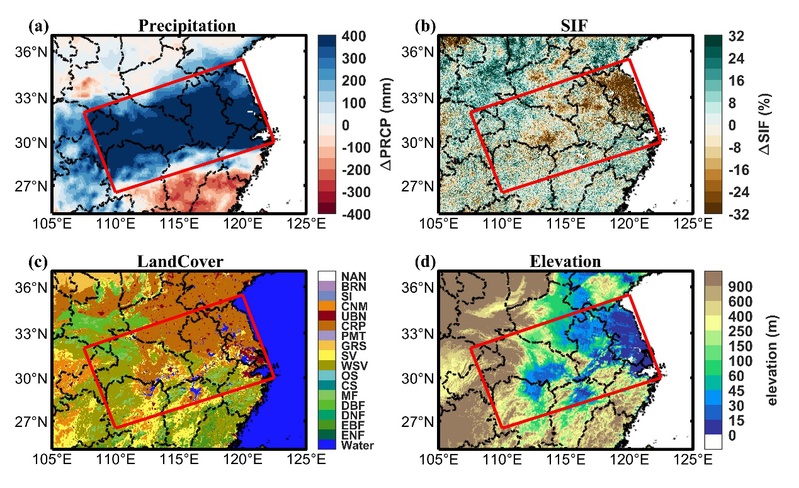Extreme precipitation events have posed a threat to global terrestrial ecosystemsunder a warming climate in recent decades. The wider swings between deficient and excessive precipitation lead to more natural hazards including floods and droughts, which have profound impacts on terrestrial ecosystems and socioeconomic systems. In the summer of 2020, anextreme Meiyu event occurred in the middle and lower reaches of the Yangtze River, which broke the observation records since 1961.The affected area, covering a major breadbasket and certain megacities of China, suffered great crop and economic losses.
Professor Weidong Guo and Associate Professor Bo Qiu's team used remote sensing data and atmospheric reanalysis data to study the impact of the extreme Meiyu event on the terrestrial ecosystem. They found the remarkablespatial heterogeneity of vegetation photosynthesis responses to extreme precipitation, which were regulated by both vegetation types and topography. The negative impact of extreme precipitation on photosynthesis of human-managed crops was significantly higher than that of natural vegetation, causing by the high vulnerability and exposure of the former.The higher vulnerability of crops may be caused by the relatively simple canopy structure,low biodiversity of croplands (resulting in the lower enhancement of utilization efficiency of scattered light in rainy days)and the low plant height and shallow roots of crops (led to the more prone to root hypoxia and to be submerged). At the same time, the location of croplands exacerbated the damage of extreme precipitation on cropssince theywere mainly distributed in low-altitude plain areas.Low-lying and flat terrain made it harder to drain, increasing the exposure to waterlogging.
This study indicates that the crops in the low-lying plains are facing greater risks to extreme precipitation. Given that the frequency and intensity of extreme flooding events are likely to increase under the warming world, this study highlights the urgent need for effective management and adaptive measures of food security in the future.
This study is published in Environmental Research Letters, entitled Divergent response of crops and natural vegetation to the record-breaking extreme precipitation event in 2020 modulated by topography. The first author of this paper,JiuyiChen, is a graduate student directed by Professor Weidong Guo. The corresponding authors are Associate Professor Bo Qiu and Professor Guo Weidong. Post-doctoral student Xin Miao and master student LingfengLi are co-authors. This research is supported by the Frontiers Science Center for Critical Earth Material Cycling of Nanjing University, the Fundamental Research Funds for the Central Universities (14380191, 14380172), the National Natural Science Foundation of China (42175136), and Jiangsu Collaborative Innovation Center for Climate Change.
Reference:
Chen, J., Qiu, B., Guo, W., Li, L., & Miao, X. (2023). Divergent response of crops and natural vegetation to the record-breaking extreme precipitation event in 2020 modulated by topography. Environmental Research Letters, https://doi.org/10.1088/1748-9326/acdaae

Figure (a) and (b) show the spatial distribution of precipitation anomalies and sun-induced chlorophyll fluorescence anomalies in eastern China from June to July 2020, respectively. Figure (c) and (d) show the distribution of land cover types and altitude in the study area, respectively.
